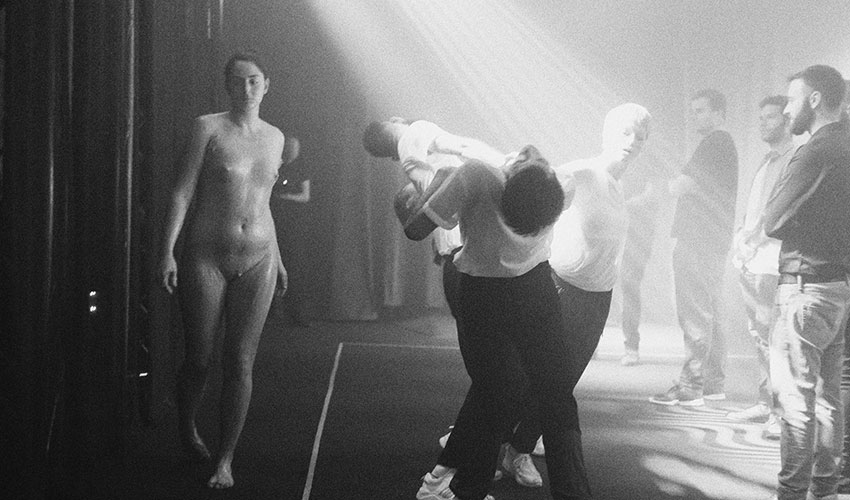Text by Lula Criado

Immersive sound offers space itself as a new instrument to play with – for musicians and sound artists; this opens the door to completely different approaches to composition and improvisation; it literally is an additional instrument to play with. With this vision, Christian Duka embarked on an ambitious project currently already spanning several years. After a short hiatus, Duka is back with a revamped project, a new sound Soundsystem and a series of residencies and performances. Christian Duka is a curator, sound designer and music artist of that generation of creatives that emerged in the wake of digital technology. He also lectures Electronic Music at SAE Institute London and curates sound-driven interdisciplinary art in immersive environments.
One of those artistic experiences that Duka is immersed in is AMOENUS, a series of artistic experiences addressing the use of space as an artistic tool. After five immersive experiences in 2019 at Aures London, Duka realised that AMOENUS wasn’t just a curatorial project. An essential aspect of the series was teaching artists, audiences and curators alike new ways in which sound and public performances could be experienced.
This led him to turn AMOENUS into a non-profit organisation whose scope is to educate, curate and promote sound-based immersive art. Then he realised that the only way to go further was to own an immersive sound system that could be easily installed in any space/venue in all sorts of immersive audio configurations.
Diving into the technical specification of the sound system, Duka tells us that the speakers have been designed according to advice received by Serafino Di Rosario, the speaker boxes are being built by designer Tim Sargent, and B&C Speakers have sponsored the speaker drivers.
Nowadays, very little is known about how 3D audio works. There are only three spatial dimensions – X (length), Y (width) and Z (height) – 3D audio is sound that travels across all of them. On the other hand, stereophonic sound can physically move across one direction – classically left and right. It is the simple fact that 3D audio allows us to move sounds in three dimensions, around and above us that gives it its beauty.
Immersive sound offers space itself as a new instrument to play with – for musicians and sound artists; this opens the door to completely different approaches to composition and improvisation; it is an additional instrument to play with. More than that, there is an automatic effect related to dealing with immersive sound systems – you can’t separate the performance area from the “witnessing” audience area, as this would escape the whole point of doing something “immersive”.
Considering that immersive audio has been around for about 50 years, I am underwhelmed by its status in the arts today. I mean, it indeed is praised and highly regarded. Still, it is very much underexplored and boasted more for its “wow factor” rather than the added experiential value it can bring to artistic experiences. Duka explained when we asked about the status of 3D/4D audio in the arts today.

After being granted by Arts Council England to get the sound system custom-made, in November, Duka will do a “Proof Of Concept” test at IKLECTIK. Considering this a “flight test” for AMOENUS, he realised that the best way to experiment with hosting R&D was to widen the scope of the research – I wanted to see completely different approaches in action.
I expect artists/researchers and AMOENUS to come out of the R&D with new ideas about using 3D sound – I’d like to see them asking questions and trying things out, truly experimenting with the technology to see how far it can take them in their research. It will teach me about different approaches to this upcoming art form and other ways in which audiences can be included/involved in the performances (actively or passively). Duka continues when asked about his expectations from these live performances.
There will be four pieces of research in total, each of them taking place for a maximum of 2 days. The first will be led by AVSLUTA, a sound artist exploring 3D sound in the context of object-based improvisation. The second will be dedicated to an artist selected by an open call. The third will see choreographer PELL ENSEMBLE using sensor technology to explore the interaction between sound and movement. Finally, the fourth will welcome six deaf people, led by Deaf Rave’s organiser Troi Lee, to explore haptic technology. The idea is to let deaf people teach non-impaired people about their perception of sound.
Thinking about the future, Duka told CLOT that he would love to see AMOENUS embark on large-scale projects – this doesn’t mean engaging hundreds/thousands of people simultaneously, but rather working on intricate and progressively more ambitious projects.
I hope to see a widening of the scope of what we do – a constant exploration of what immersive audio has to offer, with a special focus on how audiences are engaged in the process. When the sound marries moving bodies (dance, theatre, interacting and participatory practices), you must account for the audience’s role in the performance, even if they are standing there. Duka continues.
This is radical because artists and performers rarely involve audiences in the artistic experience. Duka thinks we should do that now more than ever to challenge the passive, consumerist tendency typical of our modern times. Before AMOENUS, Duka started working on the design of a new participatory piece called II, which is a sort of a continuation of his previous piece UR: Human Presence. The idea of a hypothetical piece he curated for AMOENUS would be to blend performers and audiences into an act that meditates on intimate relationships between people today. If I could, I would focus all of my energies on making this piece.






